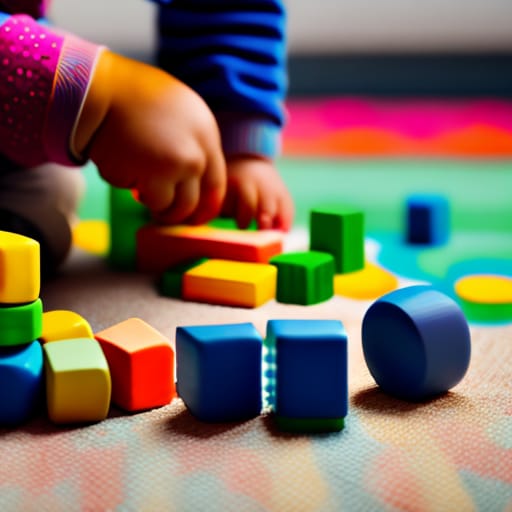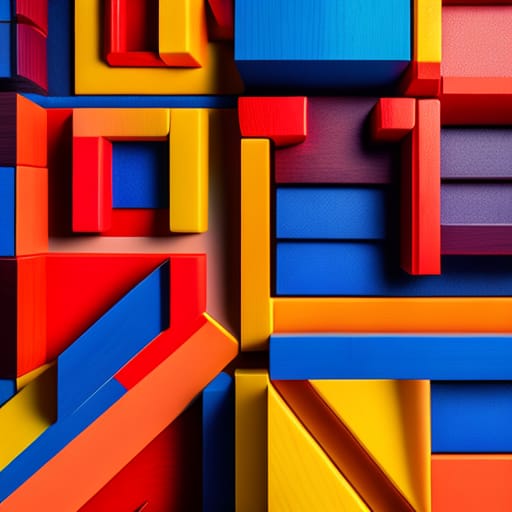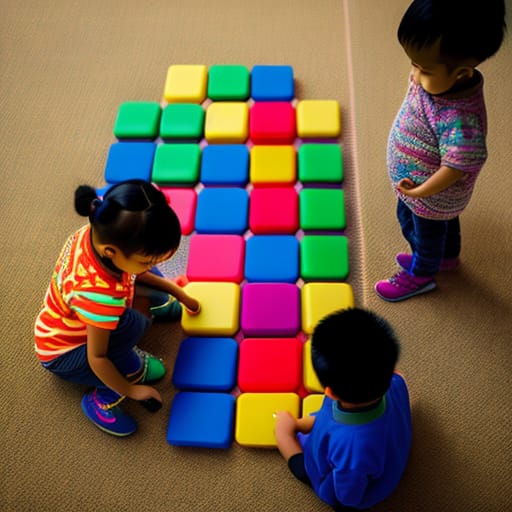Building blocks are a classic toy that has enthralled children for generations. More than just a fun playtime activity, building blocks offer numerous developmental and educational benefits for kids. As your child approaches the age of 4, introducing building blocks into their routine can support cognitive, social-emotional, fine motor, and early literacy skills.
Why Are Building Blocks Great for 4 Year Olds?
Around age 4, children have developed the dexterity, problem-solving abilities, and imagination needed to really engage in block play.
Some key reasons why building blocks hit an educational and developmental sweet spot for 4 year olds:
- Strengthen fine motor control needed for tasks like writing through grasping, stacking
- Enhance spatial intelligence and visualization of shapes, designs
- Build early STEM skills like engineering, balance, and geometry
- Provide opportunities for creative expression through building
- Develop vocabulary and language abilities by describing and naming structures
- Allow experimentation, trial-and-error needed to grow executive functioning
- Spark collaborative play through sharing ideas and materials
- Cultivate persistence and self-regulation through complex building goals
With the right blocks and a little guidance, you can transform simple play into an enriching learning experience.
Stages
Cognitive Skills Strengthened by Building Blocks
Building blocks target several key cognitive abilities that drive learning in preschool and beyond.
Spatial Intelligence
Stacking blocks in three dimensions boosts spatial reasoning and visualization skills. Children must plan designs and orient shapes, developing the spatial intelligence needed for math, maps, geometry, and more.
Mathematical Thinking
Count and sort blocks by size, shape and color, lay foundations for STEM skills. Explore concepts like balance, symmetry, patterns, fractions.
Problem Solving
Work through challenges like balancing tricky structures or replicating designs encourages flexible thinking, critical analysis, and perseverance.
Language Development
Describing what they are building, shapes and colors used fosters vocabulary. Storytelling and role playing builds narrative skills.
With a little guidance, you can turn block play into a full mind workout that builds cognitive competencies across subjects.
Social and Emotional Benefits of Block Play
Just as crucial as academic skills, preschool aged kids are developing core social-emotional abilities. Free, unstructured play with blocks allows children to:
- Increase focus, attention span through self-directed play
- Express creativity, individuality through block structures
- Cultivate sharing, turn-taking with peers during collaborative building
- Regulate frustration and cultivate patience through trial and error
- Gain sense of achievement, self-esteem from completing structures
Guiding collaborative block activities teaches essential skills like communication, cooperation, and empathy.

Making Block Play Educational
Block play has intrinsic educational value, but parents and teachers can enhance it with a few simple adjustments:
Ask guiding questions
Instead of silence, engage kids in a dialogue about their structure – what shapes are they using? How will they make the tall tower not fall? This builds language and problem-solving muscles.
Introduce challenges
Add challenges like using a certain color or shape or makingsymmetrical designs. Working within “rules” grows critical thinking and focus.
Display educational concepts
Build real-world items like zoos or cities and tie concepts like size, shape, and quantity into play. Connect block structures into themes like construction sites orclassrooms to drive additional vocabulary.
Making play more goal-oriented develops executive functioning and integrates informal learning.
Best Building Blocks for 4 Year Olds
With the overwhelming options on the market, choosing the right building blocks may seem difficult. Look for the following age-appropriate features:
1. Large, basic shapes
Blocks with simple geometric shapes allow for more versatility and imagination. Large, chunky blocks are easier for small hands to manipulate.
2. Detail elements
Wheels, eyes, letters let kids embellish basic structures. These pieces spark added creativity and storytelling. Avoid tiny accessories that pose a choking risk.
3. Solid wood
Sustainably sourced wood offers exceptional durability to withstand hours of use. Plastic breaks more easily under pressure from enthusiastic builders.
4. Non-toxic & water-based paint
Ensure paint won’t chip or flake and blocks can be washed repeatedly after messy play. Zero nasty chemicals!
The most versatile, educational blocks check all these boxes to keep kids learning through years of heavy duty use. Let’s look at two top-rated options that combine safety, simplicity, and durability.
| Grimm’s Rainbow Wooden Building Blocks | Hape All-in-One Wooden Kid’s Building Blocks and Construction Play Set | |
|---|---|---|
| Description | 70 piece rainbow-colored block set | 80-piece blocks and accessories kit |
| Materials | Solid beech wood, water-based paint | Solid wood maple blocks, birch plywood details |
| Shapes/Size | Arches, ramps, cylinders – 2” sized chunks | Cubes, cylinders, arches, rectangles – up to 3” |
| Accessories | None | Wheels, doors, windows, animals |
| Price | $$ | $$$ |
| Age Rating | 3 years + | 2 years + |
| Key Benefits | ● Bright colors inspire creativity<br>● Gentle curves develop spatial skills | ● Details allow role play and storytelling <br>● Scoop for easy clean up |
These open-ended sets allow kids to build almost anything their imagination dreams up. Durable wood construction ensures years of use.
Setting Children Up for Success with Blocks
While building blocks inherently captivate and teach kids, parents play a key role in maximizing their potential. Here’s how to set your 4 year old up for success:
1. Designate space – Provide a consistent play spot like a rug or table where structures can stay intact for days. Having an established home base helps focus play.
2. Rotate regularly – Switch out block sets or accessories every month to fuel engagement and new ideas. Look for complementary toys like play people, signs, cars.
3. Play together – At least initially, sit down together and guide play with questions and new vocabulary. Demonstrate stacking techniques and collaborative skills.
4. Let go – Once your child gets comfortable, slowly pull back and let them experiment. Block play allows kids to take the driver’s seat, learning through trial and error.
Simple blocks may seem basic next flashy electronic toys but they provide an open-ended digital detox. Guiding your 4 year old’s block explorations gives a targeted learning boost while allowing pure imagination and fun.

The Takeaway: Why Building Blocks Should Be in Every Preschooler’s Playroom
For over a century, building blocks have sparked creativity in generations of children, but they offer so much more than fun. As this guide outlines, block play uniquely hits physical, cognitive, social, and emotional milestones for 4 year olds.
Open-ended play with colorful chunky blocks builds fine motor control needed for writing while strengthening spatial intelligence through visualization of shapes and structures. Math skills are integrated into counting, sorting, patterning activities.
Collaborative building cultivates communication and empathy as kids express ideas, compromise, and work together towards common goals. Solo construction rewards perseverance and imagination.
Trees and tablets will come and go, but classic wooden blocks endure as the hands-on learning tool that ignites little minds. There’s no better primer for preschool success than an afternoon with a pile of blocks – be sure to add them into your child’s regular play rotation.
Frequently Asked Questions
What are the best building blocks for 4 year olds?
The best building blocks for 4 year olds feature large, chunky pieces made of durable materials like wood. Simple shapes like arches, ramps, and cylinders allow for more creativity. Accessories like wheels, doors, and windows facilitate role play and storytelling. Sets with around 70-80 blocks offer enough variety for open-ended building. Prioritize safety with non-toxic paints.
How do building blocks help child development?
Building blocks promote crucial cognitive, social-emotional, and physical developmental milestones for preschoolers. Stacking and balancing pieces builds spatial intelligence and fine motor control. Sorting blocks grows early math abilities. Describing constructions develops language and vocabulary. Collaborative building encourages communication, cooperation and problem-solving skills.
What skills do children learn playing with blocks?
The open-ended nature of block play supports a wide variety of educational skills including STEM concepts (balance, geometry, patterns), language development through storytelling, creativity and imagination through inventing structures, focus and self-regulation by working towards building goals, critical thinking and spatial reasoning by manipulating shapes.
Should I be actively involved in my 4 year old’s block play?
While independent play is important, parents play a key role in making block play educational. Sit down initially to model stacking techniques and engage kids with questions that encourage problem-solving and introduce new vocabulary. Set challenges related to color, shape or balance to support specific cognitive skills. Then fade guidance so kids can follow their intrinsic motivation.
What are activities I can do using my 4 year old’s building blocks?
Beyond free-form building, a few activities make block play even more educational: build structures related to real-world places kids know like a zoo or classroom to reinforce vocabulary and themes, create puzzle-like block patterns for kids to replicate working on spatial skills, invent block games that involve math concepts like sorting by color or shape, use blocks to tell a story and encourage literacy.
Are there tech alternatives I should consider instead of regular blocks?
While smart tech toys promise educational value, simple wooden blocks have enduring developmental benefits no gadget can replicate. The sense of accomplishment from manually balancing towers or the creativity from inventing new structures with traditional chunky blocks build spatial intelligence, fine motor control and problem-solving that digital toys do not require.
